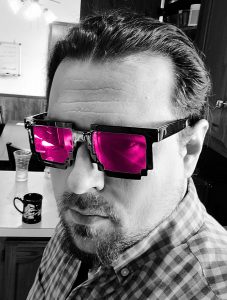How to Fix Your Ornithopter: The Unlikely Publishing History of Dune
by Jeremy Zentner
In the ever-changing age of technology, the opportunities for publication are as daunting as they are diverse. I don’t think anyone can argue that it’s easy to find success as a writer. However, as a writer, it is prudent to remember that even the legends employed their own cunning to find publication and readership in a world saturated with competition. In point of fact, one of the most renowned and best-selling sci-fi authors of all time, Frank Herbert, had to squeeze his book into a niche market before digging up the riches of Dune. With Villenueve’s film adaptations taking fans by storm, I’ll review how the unlikely success of one of science fiction’s best-selling books began next to do-it-yourself car manuals.
It’s important to remember that Dune was initially serialized in Analog magazine under the titles “Dune World” and “The Prophet of Dune.” So, while the story of Dune succeeded in a periodical, the sheer size was too pricey for publishing houses to print as one book. In addition, nobody wanted to publish the book installments (what would become the three books in Dune) as a trilogy. Herbert was rejected twenty different times from the traditional fiction markets, with Analog as Dune’s only platform. A noble beginning, to be sure, but the spice would never flow into pop culture without a whole book on the shelves. However, there was one thing that Analog did procure for Frank Herbert that no publishing house could: a connection.
You see, Sterling E. Lanier was an editor for Chilton Books, a nonfiction publishing house known for their manuals on auto-repair. Lanier was a science fiction author himself, as well as a mega-fan of “Dune World.” Even before the entire serial was completed, Mr. Lanier reached out to Herbert’s agent with an offer to publish a whole book at Chilton Books. The offer was accepted, and a few months later, in 1965, the auto repair company published its first fiction novel, Dune. According to his son Brian, Frank Herbert would sometimes crack that Chilton may change the title to How to Repair Your Ornithopter.
Despite a publishing contract, Dune’s initial success was slow. Chilton priced the 412-page novel at a whopping $5.95, which is over $56 today. On top of this, they printed a mere 2,200 copies for the first edition. Sales were so bad that Sterling Lanier was dismissed from Chilton after the first year of publication. Regardless of Chilton’s lackluster production, Dune went on to win the Nebula and the Hugo awards. At the time, Herbert’s book resembled a genre in science fiction called “New Wave.” This was essentially soft sci-fi, or science fiction that focused on the storytelling, and less on the technology. Frank Herbert managed to get his New Wave space opera into the hands of the public when the demand for newer science fiction was just gaining momentum.
In addition to the critical acclaim, it wouldn’t be too long before the environmental magazine Whole Earth Catalog would sing Dune’s praises and sell large quantities of the novel at 97 cents a pop. With the high praise and more affordable print, the readership expanded to environmentalists, dramatically increasing sales. Herbert also worked at the Examiner, later the Seattle Post Intelligencer, as education editor, serialized five other non-Dune books, drafted his only non-sci-fi book, Soul Catcher, and placed Dune Messiah on the bookshelves by 1969.
What a writer should take from this is simple: the hustle. It’s an old adage, but a writer is always writing, and Frank Herbert was no exception. Even if sales are not the best, an author’s goal should always entail the production of more content, whether it’s a new project or a sequel to previous work. Like a brand, the more often a writer produces content, the more likely they are to impact literature. Coinciding with this, public speaking is another technique to expand readership.
It can be a dreaded prospect, but shaking hands and making speeches nationwide strengthened readership for Dune. Frank Herbert was a celebrated orator at universities, giving speeches to college-age students keenly infatuated with ecological conservation and drug use. By the early 1970s, Chilton sold 6,500 hardbacks, and Ace would make a bestseller out of Dune in paperback, further expanding the readership far beyond the first year’s disappointments.
With the advances in remote communications, there are even new opportunities to reach out to fans and increase readership personally. While traditional writers’ conferences still exist, video appearances add new opportunities to solicit readership from the comfort of one’s home. In conjunction with this, social media and blogging allow authors to reach out to fans without some of the stresses that public speaking may present. Frank Herbert, I’m sure, would have milked these resources for all they are worth.
With all of Dune’s long-term success, it’s important to remember some key points. Over twenty different publishing houses initially rejected Dune. When Frank Herbert got a publishing deal, it was because the editor Sterling E. Lanier searched Herbert out after falling in love with the story he read in Analog. With this in mind, Frank Herbert hustled as a writer, spoke as a master brander, and always pursued his career with vigor. He captured the minds of a younger generation and, perhaps luckily, rode the trends for a new demand in science fiction. Frank Herbert’s tenacity as a writer and as a communicator created the conditions for an unprecedented chain of events that made Dune a cultural icon.
 Jeremy Zentner is a librarian and a sci-fi addict. He has published short stories in sci-fi and supernatural fiction. He lives in rural Illinois, USA.
Jeremy Zentner is a librarian and a sci-fi addict. He has published short stories in sci-fi and supernatural fiction. He lives in rural Illinois, USA.


